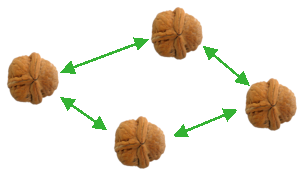Wireless Ad-hoc Links using robust Noise-based Ultra-wideband Transmission (WALNUT)

PROJECT SUMMARY
A challenging requirement of the nodes in a wireless sensor network (WSN) is the ability to operate in very harsh radio conditions while consuming very little power. The latter is required to achieve long battery lifetimes, or even enable batteryless operation through energy harvesting. Low power consumption is achieved by communicating at very low duty cycles, i.e. the radios transmit their data in very short bursts, and are switched off typically more than 99% of the time.
A common method to cope with harsh radio conditions, such as multipath fading and interference, is to spread the transmitted signal over a large bandwidth, for instance using spreading sequences, ultra-short pulses, or frequency hopping/sweeping. A drawback of most of these methods is that the corresponding receivers are required to spend relatively long time on synchronizing their local spreading signal to the received spreaded signal, in order to achieve proper de-spreading. This is prohibitive in WSNs, as long synchronization times significantly increase the power consumption of both the transmitters and receivers in case of low-duty-cycle operation.
A well-known method to achieve fast signal acquisition while transmitting at large spreading factors, is to use so-called transmitted reference (TR) modulation. This means that the spreaded data signal is transmitted along with the unmodulated spreading signal, separated either by a time delay or a frequency shift, so that they can be distinguished at the receiver. As long as this time delay or frequency shift is known in the receiver, signal acquisition can be performed relatively fast, and the receiver does not require knowledge on the actual spreading sequence. Therefore the (pseudo-random) spreading signal might as well be replaced by a (random) noise carrier, possibly bringing advantages both in implementation and power consumption. The latter idea was inspired by a similar scheme in optical communications, and forms the basis of the WALNUT project.
AIM
The aim of the WALNUT project is to develop new techniques for establishing robust radio links in WSNs that operate in an extremely crowded radio spectrum, at very low power, using noise-based TR modulation.
Specific research topics are
- choice of a suitable noise-like carrier, modulation format, data/reference separation technique, and channel coding;
- influence and mitigation of channel fading and interference;
- analog circuit design and realization in CMOS;
- dedicated MAC and networks protocols.
The research work is carried out by three PhD candidates in three different groups.
PARTICIPATING UT GROUPS
- Telecommunication Engineering (TE)
- Integrated Circuit Design (ICD)
- Design and Analysis of Communication Systems (DACS)
PARTICIPATING COMPANIES
PARTICIPATING TE MEMBERS
RELATED PUBLICATIONS
- J. C. Haartsen, A. Meijerink, A. Bekkaoui, A. Taban, and J. L. Tauritz, Novel wireless modulation technique based on noise, 11th Annual Symposium on Communications and Vehicular Technology in the Benelux (SCVT’2004), Ghent, Belgium, 9 November 2004, paper 8.
- J. C. Haartsen, X. Shang, J. W. Balkema, A. Meijerink, and J. L. Tauritz, A new wireless modulation technique based on frequency-offset, 12th Annual Symposium on Communications and Vehicular Technology in the Benelux (SCVT’2005), Enschede, the Netherlands, 3 November 2005, paper P10.
- A. Meijerink, S. L. Cotton, M. J. Bentum, and W. G. Scanlon, Noise-based frequency offset modulation in wideband frequency-selective fading channels, 16th Annual Symposium on Communications and Vehicular Technology in the Benelux (SCVT’2009), Louvain-la-Neuve, Belgium , 19 November 2009, paper 2.
